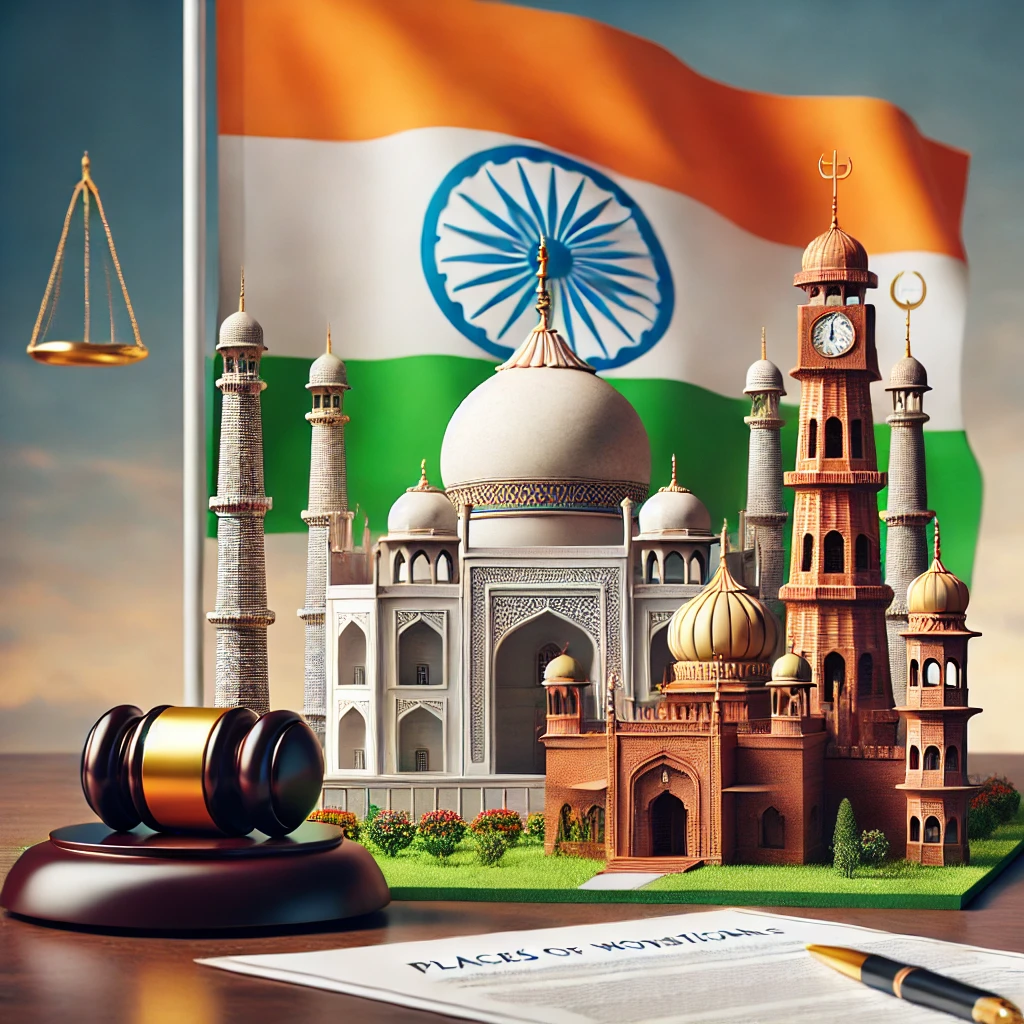
Abstract
The Places of Worship (Special Provisions) Act, 1991, is a landmark piece of legislation in India aiming to preserve the secular character of the nation. In an attempt to freeze the religious character of places of worship at what they were on 15 August 1947, the Act hopes to prevent communal discord and facilitate societal harmony. Its enactment during the volatile period of the Babri Masjid-Ram Janmabhoomi dispute underscores its significance as a tool to mitigate potential religious conflicts. This paper examines the Act’s historical context, legislative intent, key provisions, and its implications in contemporary India. It also critically analyzes the judicial interpretations and controversies surrounding the Act, highlighting its relevance in upholding constitutional values and fostering unity in a diverse and pluralistic society.
Introduction
Although India is a place of extreme cultural and religious diversity, this land has been home to several faiths for ages, providing it with a unique identity. Yet, this diversity is also responsible for conflicts over places of worship, threatening the secular foundation of the nation. Since such religious place disputes have a huge probability to jeopardize community harmony, the Indian Parliament passed the Places of Worship (Special Provisions) Act, 1991, to try to create some legality that can maintain the religious places status quo existing as of August 15, 1947, with a vision to prevent conflicts in future and build the spirit of mutual respect amongst communities.
It happened during the peak communal tension, especially over the issue of Babri Masjid-Ram Janmabhoomi. The disputed question had deep implications for both communities involved and for the very ethos of India’s secular and democratic character. In freezing the religious character of places of worship as it stood on the eve of independence, the Act was an attempt to redress historical grievances without allowing religious identities to be politicized.
This paper examines the historical context of the Act, its legislative process, and its contribution towards constitutional values. It will also discuss the legal and societal issues that the Act poses as a whole, which reflects the importance of the act in modern India.
Background History
The Places of Worship Act was a creation of a historical context surrounded by religious conflicts and necessity for a unified national identity at large:
-
Partition and Communal Violence
The partition of India in 1947 resulted in communal violence sweeping across the country, something that would forever be seared into the collective psyche. Religious tensions, which were highlighted by disputes over places of worship, made legislative recourse a necessity to prevent any such conflicts in the future. The Act’s tendency to maintain the status quo reflects an attempt to soothe historical wounds and promote reconciliation.
-
Babri Masjid-Ram Janmabhoomi Dispute
This has resulted in increased conflict over the Babri Masjid in Ayodhya, and thus is one of the major catalysts that led to the enacting of the Act. Rumors that the mosque stood at the birthplace of Lord Ram triggered debate at national levels and led to commotion among different people’s communities. This further leads to a historical and legal question on the dispute at the Babri Masjid.
-
Constitutional Imperatives
The Act is in consonance with the secular vision enshrined in the Indian Constitution. Articles 25 to 28 guarantee freedom of religion while emphasizing equality and non-discrimination. The Act aims to strengthen these principles in order to uphold the secular fabric of the nation and prevent the misuse of religion for political purposes.
Key Provisions of the Act
The Places of Worship Act holds some very significant provisions for the maintenance of communal amity and the observance of sacred place sanctity:
-
Status Quo of August 15, 1947 (Section 4)
The Act declares that the religious character of places of worship prevailing as on August 15, 1947, should remain unchanged.
It bars filing of legal suits or proceedings to change the religious character of such places.
-
Prohibition on Conversion (Section 3)
The Act prohibits the conversion of a place of worship from one religious denomination or sect to another, thus safeguarding historical religious identities.
-
Prohibition on Judicial Proceedings (Section 4(2))
No court shall try any suit or proceedings regarding the status of places of worship. All such cases that were pending at the time of the Act being enacted were directed to be dismissed.
-
Exception to Babri Masjid
The Act explicitly excludes the Babri Masjid dispute from its purview, recognizing its unique historical and legal context. This exception has been a point of contention, raising questions about the consistency of the Act’s application.
-
Penal Provisions (Section 6)
Violations of the Act attract penalties, including imprisonment of up to three years and fines, ensuring strict compliance with its provisions.
Objectives and Legislative Intent
The main goals of the Places of Worship Act are based on the constitutional and social ethos of India:
-
Promotion of Secularism
The Act aims to promote religious harmony by preventing disputes over places of worship, thereby reinforcing the secular foundation of the nation.
-
Preserving Historical Legacy
By freezing the status of religious sites as they existed on the eve of independence, the Act acknowledges and protects India’s diverse cultural and religious heritage.
-
Avoiding Communal Violence
The prohibition on changing the religious nature of places of worship is to avoid emerging flashpoints for communal violence by maintaining social order.
-
Clear Legal Position
There is no ambiguity, nor does it encourage frivolous litigation to change the character of religious sites, making it a law of certain clarity.
Judicial Constructions
The Places of Worship Act has been tested at courts, and courts had often held that the importance of the Act lies in the maintenance of communal amity:
-
Supreme Court’s Ayodhya Verdict (2019)
In its judgment on the Babri Masjid-Ram Janmabhoomi dispute, the Supreme Court recognized the significance of the Act in maintaining constitutional morality. The court noted that the Act is an affirmation of India’s commitment to secularism and the rule of law.
-
Constitutional Validity Challenges
Critics have argued that the Act restricts fundamental rights, including the right to religious freedom (Article 25) and the right to seek legal remedies (Articles 32 and 226). Courts have, however held that the Act is a reasonable restriction for maintaining public order and promoting communal harmony.
-
Gyanvapi Mosque Case (2022)
The dispute over the Gyanvapi Mosque in Varanasi highlighted the Act’s significance in preventing fresh controversies. The Allahabad High Court emphasized the necessity of adhering to the principles enshrined in the Act to avoid escalating tensions.
-
Shahi Idgah Case (Mathura)
Similar issues came up in the context of the Shahi Idgah mosque in Mathura, where claims of historical grievances brought the Act into focus. The judiciary’s approach highlighted the need to balance historical narratives with the need for societal peace.
-
Kashi Vishwanath-Gyanvapi Case
In this case, the courts highlighted the importance of the Act in that the disputes on religious sites do not cause any disturbance in communal harmony. The provisions of the Act are discussed at length in this context.
Criticisms and Controversies
The objectives of the Places of Worship Act have received praise; however, its criticism and controversy are many:
-
Exclusion of Babri Masjid
The exception made for the Babri Masjid dispute has been criticized to be inconsistent with the broad objectives of the Act. This selective application has given way to questions about the Act’s neutrality.
-
Prohibitive Provisions
The Act has been argued to restrict the power of communities to redress their historical grievances and set aright past wrongs that may perpetuate a victim complex.
-
Political Objectives
The timing of the Act’s passage and its implications have sparked allegations of political opportunism, as critics argue that it does not address the real causes of communal tensions.
-
Judicial Overreach
The prohibition on judicial litigation has been seen as a transgression against the power of the judiciary to adjudicate disputes, which also raises concerns about the separation of powers.
Contemporary Relevance
In the context of recent disputes over places of worship, the Places of Worship Act remains a critical tool for preserving communal harmony:
-
Rising Religious Tensions
Disputes over sites like the Gyanvapi Mosque in Varanasi and the Shahi Idgah in Mathura have reignited debates about the Act’s scope and enforcement.
-
Judicial Emphasis
Courts have repeatedly pointed out the need for the Act in preserving public order and preventing the politicization of religious identities.
-
Demand for Reforms
Even as some sections demand abolition or amendment of the Act to redress historical injustices, others argue for its continued need in the protection of India’s secularism.
-
The Balancing Act of History and Harmony
The approach of the Act to freezing the status quo is such that it balances the respects of historical legacies and promotes peace in society. Therefore, the effectiveness of the act can be enhanced by proper implementation and removal of ambiguity.
Conclusion
The Places of Worship (Special Provisions) Act, 1991, is an integral part of India’s commitment to secularism and religious harmony. The Act maintains the constitutional values of equality and non-discrimination as it prevents disputes over places of worship. While it may have challenges and criticisms, the role of the Act in uniting a heterogeneous society remains crucial. As questions of identity and coexistence haunt India’s consciousness, this Act stands as a constant reminder to protect the heritage of pluralism and give justice to all communities in India.
References
- Constitution of India
- Places of Worship (Special Provisions) Act, 1991
- Full text of the Act as published in the official Gazette of India.
- Judgments of Supreme Court of India
- Siddiq (D) Thr. Lrs. v. Mahant Suresh Das & Ors. (2019): Ayodhya Verdict.
- Special Leave Petition (Civil) No. 692/2021: Discussion on constitutional validity of the Act.
- Books and Commentaries
- Newspaper Articles and Editorials







